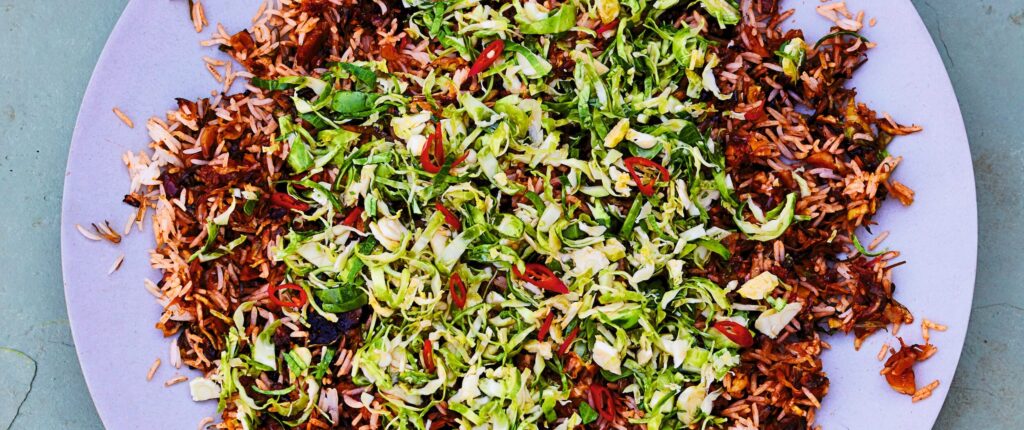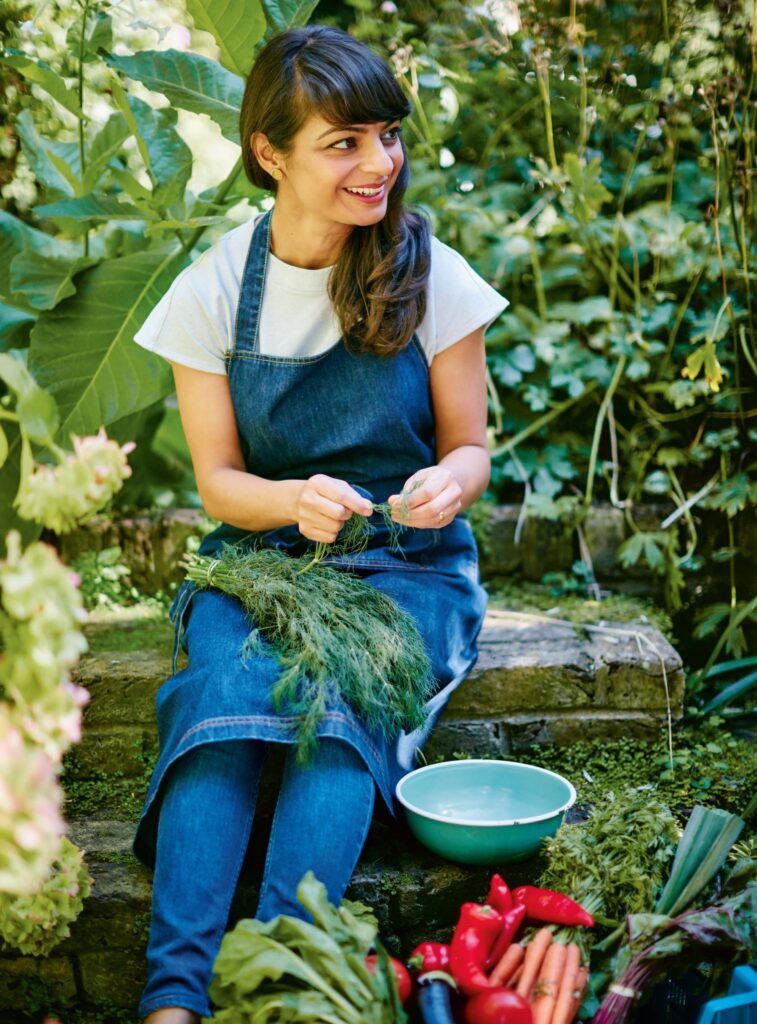If you’d like to start eating less meat, but don’t want to give up on hearty dishes with satisfying flavor, maybe it’s time to look to the east.
In her new cookbook, East, Meera Sodha shares over 120 recipes from across Asia that are so inventive and vibrant, you may not realize that every single one is meat-free. It turns out vegetarian traditions—think saag paneer, sesame noodles, or fried rice—are strong throughout the continent, from India to China and Korea. Vegetables are the mainstay, along with punchy flavors and varied textures to keep things interesting.
What makes Sodha’s book so intriguing is how she looked everywhere, from classic culinary traditions to food stands near her home in London, for this exciting mix of street sandwiches, noodle dishes, and finger foods. “Meat has traditionally been a rarity whether for religious or economic reasons,” Sodha says. “So when it came to looking for inspiration for how to eat more vegetables, it made sense to me to look to India and beyond for inspiration.” And as long as you have rice, noodles, and flour (and flavors like soy, kimchi, Gojuchang Korean chili paste, and miso), you’re ready to rock:
Brussels Sprout Nasi Goreng Serves 4
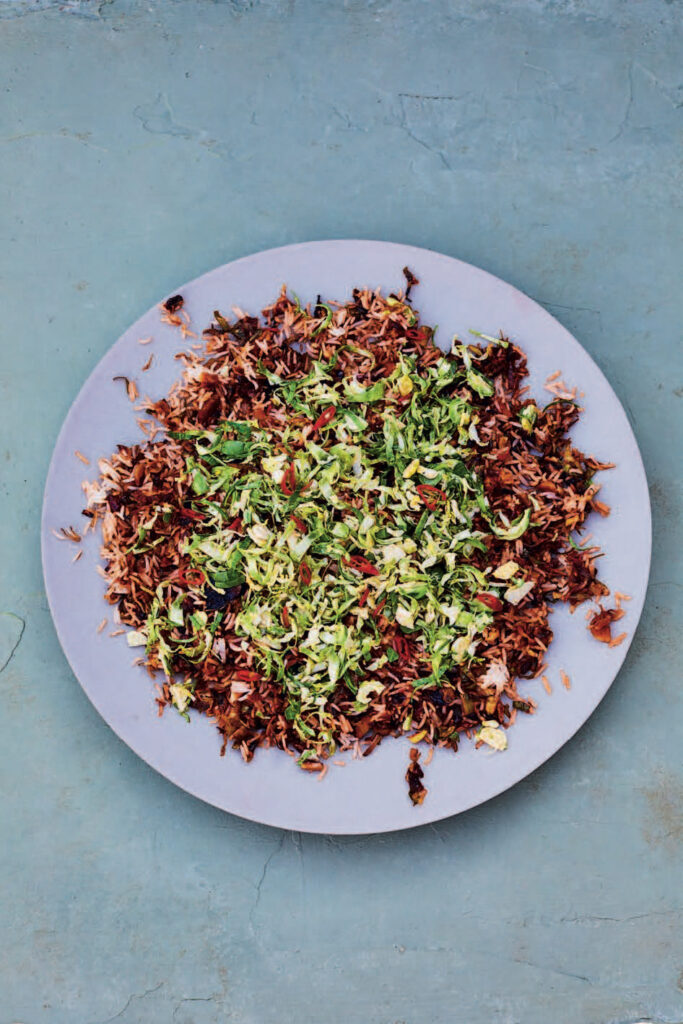
Sometimes, all you really want is something with the sort of delicious, spot-hitting taste that I used to think only good takeout could provide—until I accidentally re-created it while writing this recipe. It’s fried rice, but not as you know it: smothered in umami-ific sauces and topped with shredded, marinated Brussels sprouts for crunch and zing. All the joy of takeout, but without the wait or delivery charge.
Ingredients:
1¾ cups jasmine rice
3 tbsp canola oil
1 medium red onion, chopped
4 cloves of garlic, crushed
3 bird’s-eye chiles, very finely chopped
1¾ lbs Brussels sprouts, very finely sliced
2 tbsp tomato paste
2 tbsp kecap manis
1¼ tsp salt, plus extra to taste
2 tbsp soy sauce
2 tbsp white wine vinegar
2 tbsp toasted sesame oil
1 tsp sugar
Rice
Directions:
Place the rice in a sieve and rinse under a cold tap until the water runs clear. Tip the rice into a pan, add 2½ cups of freshly boiled water, and bring to a boil. Place the lid on, then turn the heat down to a whisper and cook for 15 minutes. Take off the heat and leave to steam with the lid on.
To cook the nasi goreng base, heat the canola oil in a large frying pan on a medium flame and fry the onion, stirring, for 5 minutes. Add the garlic and two-thirds of the chopped chiles, cook for 2 minutes more, then add all but two large handfuls of the Brussels sprouts. Fry for 8 minutes, leaving them undisturbed for a couple of minutes at a time, so they get some color on them. Then stir in the tomato paste, kecap manis, salt, and a tablespoon each of soy sauce and vinegar. Cook for another 5 minutes, then take off the heat.
To make the marinated Brussels sprouts, put the remaining raw sliced Brussels sprouts into a bowl with 1 tablespoon of soy sauce, 1 tablespoon of vinegar, the sesame oil, sugar, and the remaining chopped chiles. Mix very well and set aside.
To finish the nasi goreng, put the Brussels sprouts and onion pan on medium heat and gently scoop in the steamed rice, folding it in until well mixed. Heat through, stirring gently, for 5 minutes, until the rice is nice and hot, and season with salt to taste. Transfer to a big platter, scatter the marinated Brussels sprouts over the top and serve.
Sweet Potato and Broccolini Bibimbap Serves 4
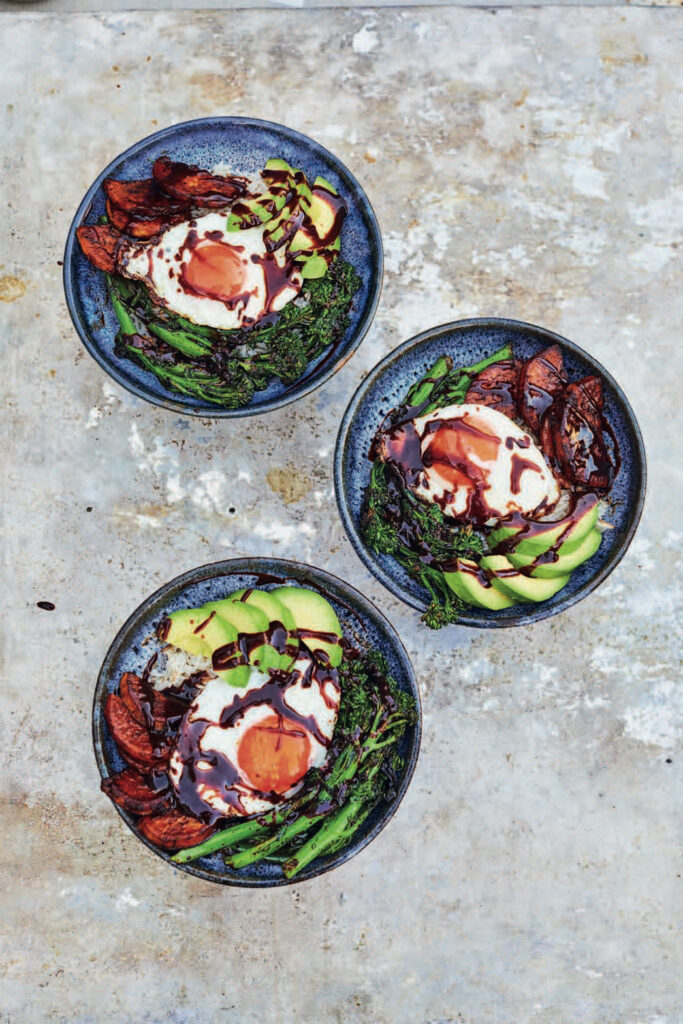
The Korean bibimbap allows for infinite variations. The only hard and fast rule is that the bottom layer should be rice, onto which vegetables, an egg, and plenty of sweet, hot gochujang sauce—a sauce that’ll make your taste buds jump for joy—are piled. I like the sweet potato and greens combination in this recipe, but corn, thinly sliced zucchini, roasted cauliflower, leeks, and snow peas also work really well.
For the gochujang sauce:
4½ tbsp gochujang paste
3 tbsp toasted sesame oil
1½ tbsp soy sauce
1½ tbsp agave syrup
1½ tbsp rice vinegar
For the vegetables:
2½ tbsp soy sauce
2½ tbsp toasted sesame oil
1 clove of garlic, grated
3 tbsp canola oil
1 lb sweet potatoes (2 medium), peeled and cut into ¼-inch rounds¾ lb broccolini, big stems cut in half
4 large eggs
2 avocados, pitted, cut into ½-inch slices, and peeled
Optional: a handful of mixed seeds (such as pumpkin and sesame), to serve
For the rice:
1¾ cups sushi or short-grain rice
In a small bowl, mix together all the ingredients for the gochujang sauce. Next, in another small bowl, mix together the soy sauce, sesame oil, and garlic for the vegetables and leave to one side.
Place the rice in a medium-sized lidded saucepan and cover with lukewarm water. Stir with your hand until the water turns cloudy. Drain and repeat, until the water runs clear, then cover with warm water and leave to soak for 5 minutes. Drain, then tip the rice back into the saucepan with 1⅔ cups of cold water. Place the pan over high heat, put the lid on, bring to the boil, then turn the heat down to a whisper and cook for 10 minutes. Take off the heat and leave to steam with the lid on.
For the vegetables, heat 1 tablespoon of oil in a large lidded frying pan. When hot, add the sweet potatoes in a single layer (you may need to fry in two batches). Fry for 3 to 4 minutes on either side (until tender), and place in a bowl to one side. Add another tablespoon of oil to the pan and fry the broccolini. Again, cook in batches if need be. Fry for 2 minutes on each side until the florets are blackening. Then add 2 tablespoons of water to the pan (careful, it may spit), cover, and steam for 3 minutes. Remove the broccolini to the plate with the sweet potatoes, pour over the soy and sesame dressing, and mix.
Finally, add 1 more tablespoon of oil to the frying pan and crack in your eggs. Fry these until the whites are just set and the yolks are still runny.
To build your bibimbap, divide the rice between four bowls. Place a fried egg in the center of each bowl, then put 4 or 5 slices of sweet potato, 5 or 6 stems of broccolini, and 4 slices of avocado around the egg, leaving the yolk and some of the white visible. Drizzle each bowl with a tablespoon of gochujang sauce, sprinkle with seeds (if using), and serve.
Cardamom Kheer Serves 4
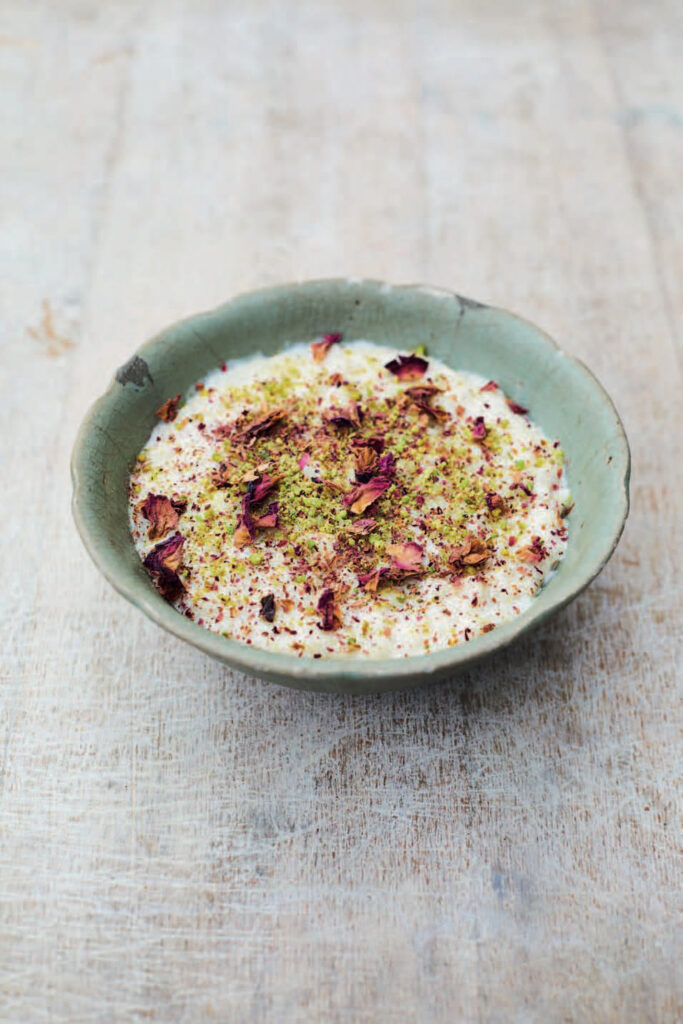
I take a bite of this sweet rice pudding and I am back at my parents’ house at Diwali. They’ve just been dancing. Arya is eighteen months old, playing with the dancing stick and shrieking with laughter. One more spoonful, and she’s six months old and just learning to eat; she doesn’t wrinkle her nose at a simple kheer made with apples. A couple more spoonfuls and it’s 2015, I’m in Bademiya in Mumbai, it’s 2 a.m. and Hugh’s just arrived. I’ve been away from him for weeks again, traveling to research recipes for Fresh India. I missed him so much I could barely eat, but now he’s here and the kheer tastes like sweet celebration. Another spoonful and I’m six again, struggling to fit in at a new school. I don’t tell Mum, but perhaps she knows because there’s kheer for pudding and it tastes like home.
Ingredients:
½ cup + 1 tbsp basmati rice
1 tsp ground cardamom
½ tsp ground cinnamon
½ cup superfine sugar, plus 1 tbsp to decorate
3 cups whole milk, plus extra if needed
⅔ cup heavy cream
3 tbsp unsalted pistachios
1½ tbsp dried edible flowers (such as marigolds, roses, lavender)
Directions:
Place the rice, spices, sugar, milk, and cream in a large saucepan and set over medium-low heat. Bring to the boil—but watch it doesn’t boil over—then turn the heat down to a whisper and cook for about 30 minutes, stirring fairly frequently to make sure the rice doesn’t stick and burn. If the mixture is getting too dry, add more milk, a little at a time. When the rice is nearly done, it will start to bubble and burp more furiously and will need more attention from you. When the rice is tender (i.e. there’s no chalkiness in the center), take it off the heat and spoon into a serving bowl. Allow to cool, then cover and chill in the fridge until cold.
Just before serving, grind the remaining tablespoon of sugar, the pistachios, and edible flowers as finely as you can, using a mortar and pestle or electric spice grinder. Sprinkle over the top, and serve.
Excerpted from EAST by Meera Sodha. Copyright © 2020 by Meera Sodha. Reprinted with permission from Flatiron Books. All rights reserved. Photography by David Loftus.




